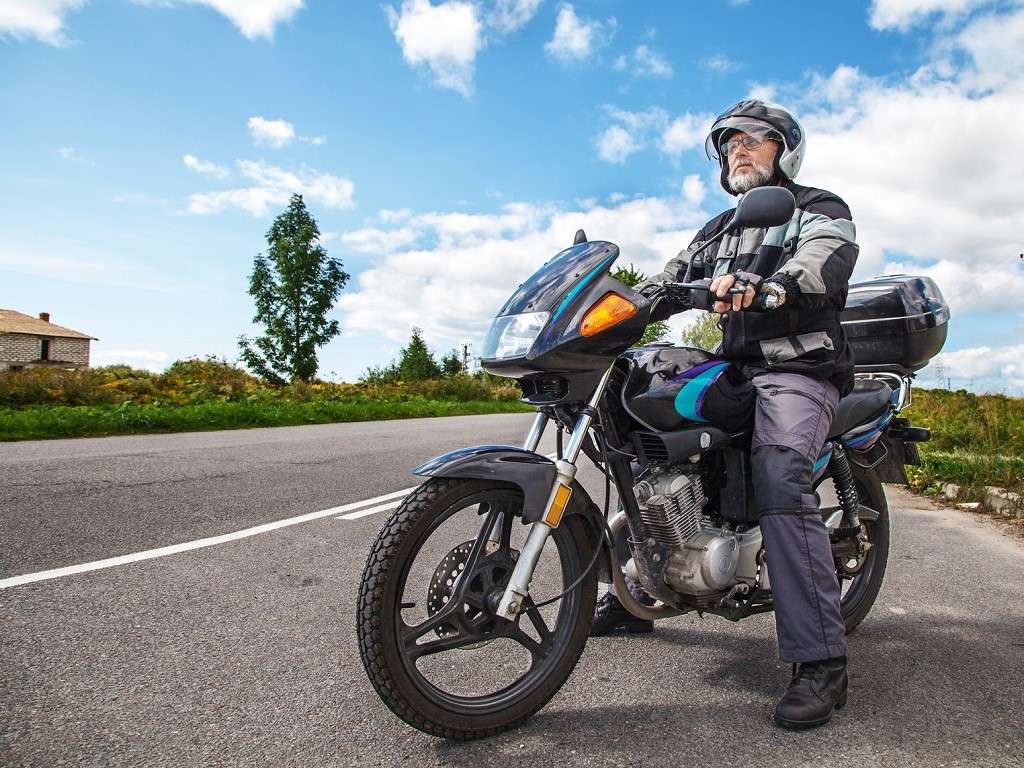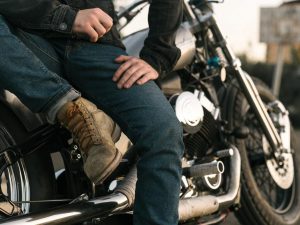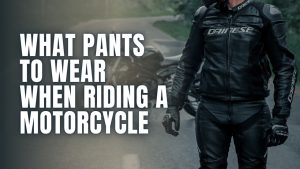When you’re finally ready to embark on an epic cross-country road trip, don’t forget about the proper gear to keep you safe and comfortable for the long haul. Choosing a motorcycle jacket is one of the most critical decisions you’ll make.
Forget the flashy, uncomfortable jackets that make you look like a wannabe Hell’s Angel. For long-distance riding, you need a quality jacket designed specifically for touring. One that will protect you from the elements, prevent fatigue, and yes, still make you look totally badass.
The right touring jacket can make the difference between the adventure of a lifetime or the trip from hell. So, let’s find out how to choose a motorcycle jacket for long distance riding.
How Do I Choose a Motorcycle Jacket for Long Distance Riding?
A long distance riding covers hundreds or even thousands of miles. So, the motorcycle jacket has to provide the comfort and safety necessary for a long journey.
Let’s dive into the key aspects you need to consider when choosing your ideal motorcycle jacket for a long ride.
1. Fit
A well-fitting motorcycle jacket is not only a matter of style but also a crucial factor for comfort, protection, and overall riding experience during long distance trips.
Why is proper fit essential? Wearing a jacket that fits you well allows for ease of movement and reduces fatigue during extended hours on the road.
Also, a properly fitting jacket provides adequate protection. It should snugly cover your torso, arms, and shoulders without being too loose or restrictive.
A well-fitting jacket acts as a second skin, offering a crucial layer of protection against abrasion, impact, and the elements. It can greatly reduce the risk of injury in the unfortunate event of a fall or accident.
Tips for finding the right size and fit.
Measurements and sizing: Start by taking accurate measurements of your chest, waist, and arms. Refer to the manufacturer’s sizing chart. Keep in mind that sizing may vary between different brands, so it’s crucial to consult the specific brand’s guidelines.
Range of motion: When wearing the jacket, perform some basic riding movements, such as reaching forward, lifting your arms, and rotating your torso. It should allow for comfortable and unrestricted motion without any binding or excessive tightness. Pay attention to the articulation of the sleeves and the flexibility of the material.
Room for layers: Long distance riding often involves varying weather conditions, so have the option of layering underneath your jacket. It should have enough room to accommodate additional thermal or waterproof layers without compromising its fit or functionality. Consider jackets with adjustable straps or expansion panels to customize the fit according to your needs.
2. Protection
A motorcycle jacket should offer robust armor to safeguard you from potential road rash and impacts.
Road rash is a common concern for riders, especially during accidents or falls. Armor plays a vital role in minimizing the risk of road rash by providing an additional layer of protection between your body and the road surface.
Here are some key points to consider:
Types of armor: Motorcycle jackets often come equipped with armor inserts made from materials like CE-approved foam, thermoplastic, or even advanced technologies like D3O. These armor inserts are strategically placed at vulnerable areas to absorb and distribute impact energy.
Armor locations: Look for jackets that have armor in the key impact zones, including the elbows, shoulders, and spine. Some jackets may also feature chest protectors for added safety. The armor should fit securely and comfortably against your body, without hindering your movement or causing discomfort.
Abrasion and impact resistance: Opt for jackets made from high-quality materials with excellent abrasion and impact resistance properties. Textile jackets often utilize materials like Cordura, Kevlar, or ballistic nylon, while leather jackets offer natural abrasion resistance. Ensure that the jacket has reinforced stitching and double or triple-layered construction in critical areas.
3. Ventilation and Temperature Control
Long distance rides can expose you to varying weather conditions, making ventilation and temperature control essential for your comfort and overall riding experience.
Proper ventilation helps regulate body temperature, allowing you to stay cool and comfortable during extended hours on the road. Riding in hot and humid conditions can lead to excessive sweating, discomfort, and fatigue.
Why ventilation is crucial
Air circulation: Adequate airflow keeps your body cool and prevents overheating. It helps wick away moisture and perspiration, enhancing overall comfort and reducing the risk of heat-related issues.
Breathability: Ventilation systems allow fresh air to enter the jacket while expelling warm air and moisture. This ensures proper breathability, preventing the buildup of sweat and odor.
YOU MAY LIKE: Best Motorcycle Pants for Summer: Top 5 Picks
Jacket features for airflow and insulation
Vents, mesh panels, and perforations: Look for jackets with strategically placed vents, mesh panels, or perforations. These allow air to flow through the jacket, providing effective cooling. Vents on the chest, back, and arms are particularly beneficial for directing airflow.
Removable liners and thermal vests: Many jackets feature removable liners or thermal vests that can be added or removed according to the weather conditions. These liners provide insulation during colder rides and can be easily taken out when temperatures rise.
4. Weather Resistance
When embarking on long distance rides, you’re likely to encounter various weather conditions, including rain and strong winds. To stay comfortable and protected, a motorcycle jacket should offer excellent weather resistance.
i. Resistance to rain and wind
Long rides can expose you to unexpected rain showers and gusty winds. A weather-resistant motorcycle jacket ensures that you stay dry and shielded from the elements.
Consider the following aspects when assessing the jacket’s resistance to rain and wind:
Waterproof materials: Some jackets are constructed from waterproof materials such as Gore-Tex or other specialized membranes. They provide a high level of water resistance, keeping you dry even during heavy rainfall.
Water-resistant materials: Alternatively, jackets made from water-resistant materials offer protection against light rain and drizzles. While they may not be fully waterproof, they have a durable water repellent (DWR) coating that helps shed water and keep you reasonably dry.
Windproof design: A windproof jacket prevents cold air from penetrating through the material, reducing wind chill and maintaining your body’s warmth. Look for jackets that feature windproof panels or a design that minimizes wind penetration.
ii. Waterproof vs. water-resistant materials
Understanding the difference between waterproof and water-resistant materials can help you choose the right jacket for your long distance rides:
Waterproof materials: Jackets made from waterproof materials provide an exceptional level of protection against rain. They feature advanced membranes or coatings that create a barrier, preventing water from seeping through. These jackets are ideal for riding in heavy rain or prolonged exposure to wet conditions.
Water-resistant materials: Jackets made from water-resistant materials offer moderate protection against rain. While they may repel water to some extent, they are not designed to withstand heavy downpours or prolonged exposure to wet conditions.
Water-resistant jackets are suitable for light rain or drizzles but may eventually absorb water if exposed for an extended period.
YOU MAY LIKE: Beat the Rain: The Best Waterproof Motorcycle Jeans to Keep You Dry
iii. Zip-out liners
Many motorcycle jackets come equipped with zip-out liners, which provide added versatility and adaptability to changing weather conditions. These liners can be easily attached or detached, allowing you to customize your level of insulation and weather protection. For instance:
Thermal liners: Zip-out thermal liners provide additional warmth during riding in winter. They are typically made from materials like fleece or thermal insulation, keeping you comfortable and cozy when the temperatures drop.
Waterproof liners: Some jackets feature zip-out waterproof liners that can be inserted during rainy conditions. These liners act as an extra layer of defense against moisture, ensuring that you remain dry even in wet weather.
The inclusion of zip-out liners in a motorcycle jacket gives you the flexibility to adapt to different climates and weather conditions.
5. Storage
When embarking on long distance rides, having sufficient storage space within your motorcycle jacket is highly beneficial. It allows you to carry essential items, such as your phone, wallet, keys, and small tools, ensuring easy accessibility without the need for additional bags or backpacks.
Benefits of ample storage in a motorcycle jacket
Convenience: Having storage pockets within your reach saves you the hassle of rummaging through separate bags or backpacks. You can easily access your essentials without having to stop or remove your riding gear.
Organization: Dedicated pockets and compartments help you stay organized. You can assign specific items to different pockets, making it easier to locate them when needed. This ensures that your belongings are readily accessible and minimizes the risk of misplacing or losing items during your ride.
Security: Zippered or secured pockets provide added security for your valuables. Items stored in these pockets are less likely to accidentally fall out or be susceptible to theft during stops or breaks.
Types and locations of pockets and storage
Consider the following types and locations when evaluating a jacket’s storage capabilities:
Chest pockets: These pockets are typically located on the chest area, providing quick and easy access to items like your phone, keys, or small tools. Chest pockets are often secured with zippers or Velcro closures for added protection.
Internal pockets: Internal pockets are positioned on the inside of the jacket and offer additional storage for valuable items or documents. These pockets are great for keeping items secure and protected from the elements.
Cargo pockets: Cargo pockets are larger pockets usually situated on the front or sides of the jacket. They offer more storage capacity and can accommodate bulkier items, such as maps, snacks, or gloves. Cargo pockets are often fastened with zippers or flaps to ensure the security of your belongings.
Sleeve pockets: Some jackets feature small pockets on the sleeves, ideal for storing small items like lip balm, earplugs, or a spare key. These pockets are easily accessible while riding and allow for quick retrieval of frequently used items.
Back pockets: Back pockets, located at the rear of the jacket, provide additional storage space for larger items. They are useful for carrying items like a thin rain jacket or documents that you may need to access less frequently during your ride.
6. Visibility
Being visible to other road users is vital for your safety as a motorcyclist. Improved visibility allows drivers of other vehicles to recognize your presence and react accordingly, reducing the risk of accidents.
A motorcycle jacket that incorporates visibility-enhancing features is essential for increasing your presence and alerting other motorists to your presence.
Why visibility is crucial
Awareness: Enhanced visibility increases your chances of being seen by other drivers, pedestrians, and cyclists. This helps prevent potential collisions caused by inattentiveness or a lack of awareness.
Low-light conditions: Riding during dawn, dusk, or nighttime poses additional challenges due to reduced visibility. A jacket with high visibility features ensures that you stand out in these low-light conditions, making it easier for others to spot you.
Adverse weather conditions: Poor weather conditions, such as rain, fog, or mist, can further reduce visibility. Having a jacket that enhances your visibility helps compensate for these challenging environments.
YOU MAY LIKE: What Motorcycle Visibility Products Should You Use?
Reflective details and bright colors
When selecting a motorcycle jacket, consider the following visibility-enhancing elements:
Reflective details: Look for jackets with strategically placed reflective accents or panels. Reflective materials have the property of reflecting light back to its source, making you more visible to others.
Common locations for reflective details include the chest, back, arms, and shoulders. These reflective elements significantly increase your visibility, especially when illuminated by headlights or streetlights.
Bright colors: Opt for jackets available in bright and vibrant colors. Colors like yellow, orange, or neon green can attract attention and make you more noticeable on the road.
Bright colors help differentiate you from the surrounding environment and improve your visibility during the day.
7. Other Considerations
In addition to the previously discussed factors, there are several other important considerations when choosing a motorcycle jacket for long distance riding.
Let’s delve into these aspects to ensure you make an informed decision.
i. Material durability and jacket lifespan
Consider the following factors related to material durability and jacket lifespan:
Quality materials: Look for jackets constructed from high-quality materials such as leather, textile, or a combination of both.
Leather jackets offer excellent abrasion resistance and durability, while textile jackets often utilize advanced synthetic materials known for their strength and longevity.
Reinforced stitching: Check for reinforced stitching, particularly in areas prone to stress or impact, such as the elbows and shoulders. Strong stitching enhances the overall durability and lifespan of the jacket.
Care and maintenance: Proper care and maintenance of your motorcycle jacket can significantly extend its lifespan.
Follow the manufacturer’s instructions regarding cleaning, conditioning, and storage to ensure your jacket remains in optimal condition for years to come.
ii. Matching with other riding gear
While the functionality and protection provided by a motorcycle jacket are crucial, you should consider its aesthetic appeal and how well it matches with your other riding gear.
Coordinating your jacket with your helmet, pants, and boots can create a cohesive and stylish look. Look for jackets that complement your overall riding ensemble, allowing you to ride in style without compromising safety and comfort.
iii. Noise reduction features
Long distance rides can expose you to excessive wind noise, which can lead to fatigue and discomfort.
Look for jackets that incorporate noise reduction features to minimize wind turbulence and noise levels. These features can include snug collar closures, eternal neck seals, adjustable cuffs, and wind-blocking panels.
Check this forum for an interesting discussion on this topic.
iv. Electronically enabled features
Advancements in technology have introduced electronically enabled features in some motorcycle jackets, adding convenience and functionality. These features may include:
Integrated Bluetooth communication: Some jackets offer built-in Bluetooth communication systems, allowing you to connect with your phone or GPS for hands-free calling or navigation.
Heated elements: Certain jackets come with built-in heating elements that provide warmth during colder rides. These heating elements can be powered by battery packs or connected to your motorcycle’s electrical system.
LED lighting: Jackets with integrated LED lighting systems enhance your visibility even further. These lights can serve as additional indicators or provide increased visibility during night rides.
YOU MAY LIKE: A Comparison Guide Between Motorcycle Heated Glove vs Heated Grips
8. Choosing by Budget
When selecting a motorcycle jacket for long distance riding, consider your budget and find the right balance between cost, quality, and protection. While it’s natural to have budget constraints, compromising too much on quality and protection can be detrimental to your safety.
i. Cost vs. quality and protection
Here’s what you should consider when balancing cost and quality:
Invest in quality: A higher-quality jacket often comes with advanced features, superior materials, and better craftsmanship. While it may require a larger upfront investment, a quality jacket will typically provide better protection and durability in the long run.
Long-term value: Consider the long-term value of the jacket. A well-made, durable jacket may cost more initially, but it can save you money in the long term by lasting longer and requiring fewer replacements.
Certification standards: Look for jackets that meet recognized safety standards, such as CE (Conformité Européene) certification. These standards ensure that the jacket has undergone rigorous testing and meets specific protective requirements.
ii. Consider needs and riding style
When evaluating your budget, take into account your specific needs and riding style. Consider the following factors:
Frequency of use: If you plan to ride frequently or embark on long distance trips regularly, it may be worth investing more in a higher-quality jacket that can withstand the demands of intensive use.
Riding conditions: Consider the typical weather and riding conditions you’ll encounter. If you often ride in extreme climates or challenging environments, a jacket with advanced features and superior protection may be worth the extra investment.
Level of protection: Assess the level of protection required based on your riding style. Different styles of riding may demand varying levels of protection. For example, if you engage in aggressive sport riding, you may need a jacket with reinforced armor and impact protection.
Final Words
When buying a motorcycle jacket for long distance road trips, comfort, safety and weather protection should be top priorities. Choose a well-vented textile or leather jacket to keep you cool on hot days and layer up with thermal liners for colder rides. Make sure the armor and impact protection meet or exceed safety standards and fit properly for full coverage.
Explore our guides to selecting the ideal motorcycle jacket, helmet, boots, and gloves for your next long haul.
FAQs about Motorcycle Jackets for Long Distance Riding
What features should I look for in a long distance motorcycle jacket?
Water-resistant and windproof materials, armored elbows and shoulders, ventilation zippers, multiple pockets and adjustable parts.
How should a motorcycle jacket fit for touring?
The jacket should have a slightly loose fit, not too tight or too loose. The sleeves should cover the wrists and the waist should sit at the hips.
Should I buy a heated jacket for touring?
A heated jacket can be comfortable for long rides, especially in cold weather. However, they are expensive and require higher battery and connection maintenance.
What colors are best for high visibility on long rides?
Light or bright colors like fluorescent yellow, orange and lime green provide the highest visibility during the day. Reflective strips further increase visibility at night.
How often should I replace a motorcycle touring jacket?
Long distance riding puts extra wear and tear on jackets, so replacement every 3-5 years is recommended depending on intensity of use and condition of armor and protective elements.
Do mesh motorcycle jackets work for long distance touring?
Mesh jackets provide great ventilation but offer less wind and water protection. So for long trips and certain weather conditions, fully textile or leather jackets are best.
Should my touring jacket have armor?
Armored shoulders, elbows and possibly a back protector offer impact protection if you crash and are recommended for touring jackets. Make sure the armor is CE certified.
What extra features should I look for in touring jackets?
Outside pockets, zippered vents, longer sleeves, snap closures at the cuffs and waist, and waterproof zippers are all useful touring jacket extras.
Should I wear layers under my motorcycle jacket?
Wearing a base layer and mid layer makes it easier to regulate your temperature by adding or removing layers. This is recommended for long rides with varying weather conditions.




